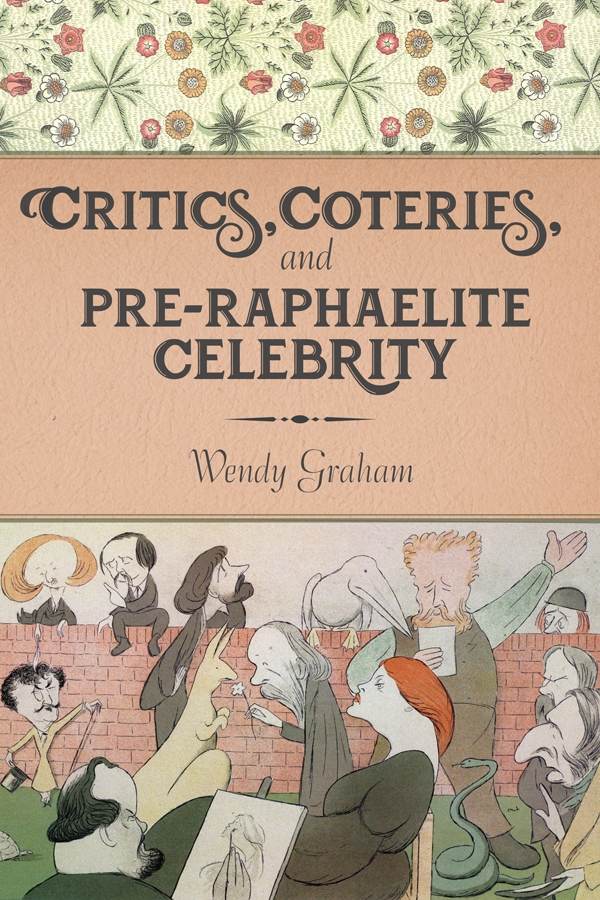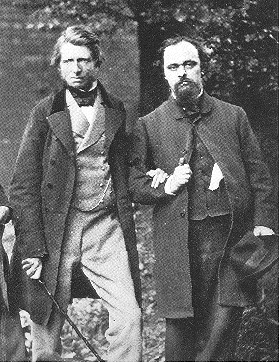This review is reproduced here by kind permission of the online inter-disciplinary journal Cercles, where it was first published. The original text has been reformatted and illustrated for the Victorian Web by Jacqueline Banerjee, who has also added captions and links. Click on the images for larger pictures and bibliographic information.

Critics, Coteries, and Pre-Raphaelite Celebrity is an entertaining if sometimes irritating study of what Oscar Wilde might have learned about the construction of celebrity from his predecessors, the Pre-Raphaelites. Like a number of other recent critics, Graham argues that "Pre-Raphaelitism is a seminal but neglected chapter in the history of the avant-garde" (xi). But she is less concerned with the art and literature than with the Pre-Raphaelites' canny manipulation of publicity, long before Wilde (who is often credited as a seminal self-publicist). Her study is also a not-so-implicit criticism of generations of scholars for defending as pure the motives of artists whom this study hopes to expose as calculating, highly successful creators of fame — the celebration of artists and writers (including D. G. Rossetti, A. C. Swinburne, and Edward Burne-Jones) who purported to stand above the desire for commercial gain but in fact fully exploited newly emerging resources of publicity (including the signed review or article) to achieve it. Graham is especially hard on modern scholars who have failed to take sufficiently into account insights from Gender and Queer Studies into the varied phenomena of eroticized male bonding that, she believes, importantly contributed to the making of Pre-Raphaelite celebrity. She is also critical of Rossetti, Swinburne, and Burne-Jones themselves for later disavowing the distinctly homosocial, if not homoerotic, feelings that held together successive "cliques" of Pre-Raphaelites and their friends and admirers (including for a time John Ruskin) around the charismatic but reclusive figure of Rossetti. The road to celebrity ran right over the Pre-Raphaelite painter Simeon Solomon, an intimate at the Chelsea gatherings in the 1860s who was excluded from Pre-Raphaelite circles and then from Pre-Raphaelite histories after his arrest for sodomy in a London public urinal.

Simeon Solomon's Self-Portrait, graphite on paper, 1859.
In other words, Critics, Coteries, and Pre-Raphaelite Celebrity has more than one argument with Pre-Raphaelite scholarship. Graham undertakes a reception history — a "thick description" (xv) — that quotes generously from seemingly everything written by contemporaries and their immediate successors about Pre-Raphaelitism in its several generational forms, from the early PRB (Pre-Raphaelite Brotherhood) of Rossetti, J. E. Millais, and Holman Hunt; through the formation in the late 1850s of a new group around Rossetti including Swinburne, Burne-Jones, and William Morris; to the various inhabitants of Rossetti's house in Chelsea beginning in 1862. (She uses "Pre-Raphaelitism" and "Aestheticism" more or less interchangeably; for her purposes, they are the same because the same culturally challenging messages and the same or similar methods of publicity were used for all three groups.) It is from the wealth of often highly amusing praise, polemic, and satire directed at the Pre-Raphaelites by contemporaries (including the visual commentary provided by the many cartoons Graham includes) that the book derives both its appeal to a more general readership and, ultimately, its evidence against those who have, she believes, misled us about the true nature of Pre-Raphaelite modernity. Their greatest achievement, or so one would learn from this book, is not the inventive forms or even the socially and sexually transgressive content of their art and their literature (the originality of which was quickly lessened as what was the forward-looking exception in the early 1850s became the norm well before the 1890s). It was the unrecognized genius by which they turned art by a small, homosocial coterie on the margins of Victorian culture into the material of celebrity, a protest against modern conditions of commercialized literary and artistic production and advertising that at the same time exploited its possibilities to the full. Wilde was right to regard them as an inspiration, if sadly mistaken to ignore the lesson of Solomon's fall.

Oscar Wilde in 1882, in a photograph by Sarony.
Readers should be warned that this is not a book about poetry or painting (one of the few quotations of more than a phrase from a poem by Rossetti is unfortunately misquoted (97); nearly as many cartoons as paintings are reproduced). Poems and paintings may be mined to illustrate the periodical commentary but are not closely read by the author for themselves. We are throughout encouraged to view the Pre-Raphaelites through the eyes of their reviewers and critics. Graham does occasionally give us her own, often insightful ideas about the literary and artistic work (her observations on Pater's and Pound's "stacked-time or symphonic approach to temporality" [112], for example). Her analysis of the psychodynamics of social and professional relationships among the Pre-Raphaelites is acute. But for much of the book Graham is voicing for us the perceptions of contemporaries, weaving together quotations from them, sometimes disconcertingly augmented by quotations from much later scholarship. (This is one of the more irritating aspects of a book that tries for a minimum of scholarly apparatus; one has to keep a finger in the notes at all times to find out who is speaking, or writing, since that may change — with no warning in the text — even within the same sentence.) While this is one way of giving us new (and often unflattering) perspectives on well-known literary and artistic figures, it might be confusing to students and non-specialists if they assume that these interpretations are always endorsed by Graham's own critical authority. Here, the second-hand — the opinions of reviewers and critics, then or now, about the work or its creators — is the primary object of study.
In several respects, this book suffers somewhat from its long gestation (the last chapter on James was separately published in 1999; the book is the product of twenty years of research and reflection, as noted in the Acknowledgements). Some subjects which were untouched when the project began have since received a good deal of attention (Swinburne's Sapphism, Solomon's underappreciated contributions in the 1860s, Pre-Raphaelite art as a true avant-garde). While Graham's notes and bibliography acknowledge some of this recent work, it still somewhat undercuts assertions in the text that may have been true when the study was begun — that scholars have neglected this or that area. Perhaps more troublingly, the study reads as though Graham herself had a difficult time deciding where she wished to focus. Different chapters announce the aims of the book as arguing for an avant-garde status for Pre-Raphaelite art, providing a reception history (using a "psycho-social model" [xvi]) of Pre-Raphaelitism, or exposing for the first time the masculine homoeroticism that gave it its distinctive, and distinctively modern, character as an aesthetic movement. The reader sometimes has the uncomfortable feeling of traveling on a constantly morphing path as chapter succeeds chapter.

John Ruskin and D. G. Rossetti, an albumen print of 1863 by William Downey.
The introduction opens with a claim that "Pre-Raphaelitism is a seminal but neglected chapter in the history of the avant-garde" [xi], and this claim is repeated at several later points in the book. Chapter One, "The Pre-Raphaelite Vanguard," focuses on the early PRB, summarizing the art's (and the artists') "provocations" and "revolutionary strategies" that "make a compelling case for the movement's avant-garde disposition" (1). (The account in this chapter is a bit summary; it is not the best part of the book). Chapters Two, Three, and Five focus on contemporary responses to successive phases of Pre-Raphaelitism. These chapters offer a richly detailed sample of "the print politics of scandal and the erotic discourse of masculinity" [xvi] that accompanied, or perhaps caused, the rise to fame of successive waves of Pre-Raphaelite art and literature. These chapters pay particular attention to the periodical articles and reviews that, in Graham's account, inflated an initially provocative art by a handful of very young cultural and sexual rebels into a widely recognized movement whose central figures became celebrities. Their fortunes, she shows, were buoyed as much by denunciation and mockery as by the fulsome (and managed) praise of a small circle of admirers. Chapter Four zeroes in on Rossetti as the central, mythic Pre-Raphaelite — his art seldom seen, his poetry until 1870 largely unpublished, while the man himself was known primarily through reports of his circle of friends and admirers. The creation of a legendary figure from a reclusive and, in later years, disillusioned, even cynical aesthetic rebel (in Graham's account) epitomizes the power of a brilliantly managed publicity campaign. She sometimes attributes this campaign to Rossetti's own manipulations, while at others suggests that it is the work of those around him, both friends and foes. The neglected importance of masculine homoeroticism in Pre-Raphaelite circles (and of the painter Simeon Solomon in particular) recurs like a leitmotif throughout this book: "Revising a history of homosexuality that others have viewed as originating in later decades, my book exhumes the collaboration among a practicing homosexual, Simeon Solomon, and the Pre-Raphaelites" (xv), "The Pre-Raphaelites have been knocked off the queer continuum, even though their aesthetic, ethos, and tone informed a British aestheticism patently identified with homosexual subjectivity" (44), "homoerotic admiration was the glue that held these disparate bodies together" (246).
This book should be welcomed by scholars working in Queer and Gender studies, whom it most directly addresses. Victorianists interested in the figure of the celebrity and the role played by periodicals will also value its detailed reception history. Scholars of Pre-Raphaelite art (and to a lesser extent, literature) will find some interesting and provocative claims to ponder. A hoped-for broader reading public will surely be amused.
Related Material
Bibliography
Graham, Wendy. Critics, Coteries, and Pre-Raphaelite Celebrity. New York: Columbia University Press, 2017. Hardcover. xxiii+327 pages. ISBN 978-0231180207. $60.
Created 12 April 2018